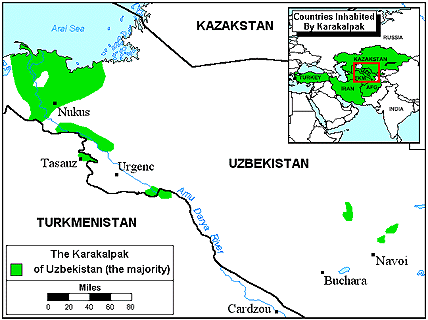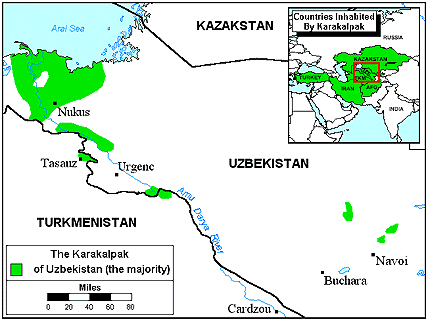Prayer Profile
The Karakalpaks of Central Asia
A cluster of 3 Karakalpak groups in 3 countries.
![[IMAGE]](../images3/0558.jpg) Most of the Karakalpaks live in Uzbekistan. However, significant numbers can also be found in Iran and Turkey, and smaller communities in Kazakstan, Afghanistan, and Turkmenistan. The name "Karakalpak" comes from two words: "Kara" meaning black, and "Kalpak" meaning hat.
Most of the Karakalpaks live in Uzbekistan. However, significant numbers can also be found in Iran and Turkey, and smaller communities in Kazakstan, Afghanistan, and Turkmenistan. The name "Karakalpak" comes from two words: "Kara" meaning black, and "Kalpak" meaning hat.
It is believed that the Karakalpaks are descendants of Iranians and Mongolians. Before the Russian Revolution of 1917, the Karakalpaks were simply a loose alliance of semi-nomadic tribes. However, in the 1920's, the Karakalpak republic was established in Uzbekistan. The Karakalpak tribes are divided into clans called uru. The uru are further sub-divided into family groups called koshes. The members of a koshe are the descendants of a common male ancestor. They share land and are extremely loyal to each other.
The Karakalpak language is divided into two dialects: northeastern, which is very similar to Kazak, and southwestern, which is more similar to Uzbek. Their language had no written script until 1930.
What Are Their Lives Like?
Of all the Central Asian Muslim peoples, the Karakalpaks are probably the least aware that they now make up their own nation. This new nation is one lacking historic traditions of its own. The Karakalpak republic in Uzbekistan is a combination of the old Khivan Khanate and the Khorezm People's Republic. This region is extremely dry and rarely receives more than 4.5 inches of rain a year.
Most Karakalpaks are settled along the river and irrigation channels of the Amu Darya Delta, which flows into the Aral Sea in northwestern Uzbekistan. Others are located near the main railroad lines, while some live along the old shoreline of the Aral Sea. The Karakalpaks in Turkey are primarily concentrated in the mountains of eastern Turkey, near the headwaters of the Murat River. Those in Iran live mainly on the southern shores of Lake Urmia, which is located in the northwestern corner of the country.
Villages are usually small, having fewer than 50 houses. The larger villages are more likely to be collective "community" farm villages. Typically, homes in these areas are small clay-walled cottages with dirt floors. Most of the urban Karakalpaks live in adobe mud houses.
Agriculture dominates the Karakalpak economy. Most of the farm land is irrigated by water from the Amu Darya River. In Uzbekistan, cotton is the major crop, accounting for at least 65% of the farm land and up to 90% of the country's income. Feed crops such as alfalfa compose nearly one-fourth of the sown area. The farmers also raise livestock for meat. Approximately half of their herds are sheep and goats. The women and adolescents are largely responsible for harvesting the crops. The men generally plant the crops, herd the animals, and fish. Many of the men and women have found work in factories.
Karakalpak societies are patrilineal, which means that the line of descent is traced through the males. Large families are the ideal, and the nuclear family is composed of as many as four generations in the same household. The Karakalpaks believe that families who share meals together will stay very close.
Traditionally, Karakalpak girls are expected to marry while still very young. The prospective groom is required to pay a "bride price" to the girl's family. After marriage, the bride leaves her home and moves in with her husband and his family. If a man dies, his wife is entitled to one half of the inheritance. The rest goes primarily to the sons.
The Karakalpaks have a history of being expert craftsmen. They enjoy adorning their homes and yurts (summer tents used by many of the rural people) with decorative carpets, wall hangings, macramé, and fringed belts. They are also recognized for their work with leather, wood, and bone. Their music, which has been passed down from generation to generation, reflects an ancient oral tradition.
What Are Their Beliefs?
The Karakalpaks are primarily Sunni Muslims and are orthodox in their beliefs and practices. In fact, religious customs are better observed by the Karakalpaks than by any other Central Asian Muslim nationality. Circumcision is practiced as a national tradition. The Karakalpak republic is also one of the major centers of Sufism (the mystic tradition in Islam).
What Are Their Needs?
For several decades, the Soviet government diverted water from the tributaries of the Aral Sea to irrigate the cotton fields of Uzbekistan. As a result, the sea has shrunk by at least 40%. The water that does reach the sea is usually filled with fertilizer, sewage, and pesticides.
The health of the Karakalpaks has deteriorated, especially those who live near the Aral Sea. Throat cancer, respiratory and eye disorders, and rates of infancy and child anemia have all drastically increased; and the infant mortality rate is the highest in the former USSR. Pesticides and fertilizer have polluted the drinking water, and traces of the same have even been found in the milk of nursing mothers. Sanitary conditions, even in hospitals, are deplorable.
The spiritual condition of the Karakalpaks is not much better. Less than 1% of them know Jesus as Savior.
Prayer Points
- Pray that God will send forth Christian medical teams to live and work among the Karakalpaks.
- Ask God to strengthen, encourage, and protect the 47 known Karakalpak Christians.
- Pray that these new believers will have opportunities to share the Gospel with their own people.
- Pray that the Lord will raise up qualified linguists to translate the Bible into the Karakalpak language.
- Take authority over the spiritual principalities and powers that are keeping the Karakalpaks bound.
- Ask God to call forth prayer teams who will begin breaking up the soil through worship and intercession.
- Pray that God will reveal Himself to the Karakalpaks through dreams and visions.
- Ask the Lord to raise up strong local churches among the Karakalpaks.

![[TABLE]](../graphics/table.jpg)

© Copyright 1997
Bethany World Prayer Center
This profile may be copied and distributed without obtaining permission
as long as it is not altered, bound, published
or used for profit purposes.
![[HOME BUTTON]](../graphics/home.jpg)
![[CALENDAR BUTTON]](../graphics/calico.jpg)
![[LIST BUTTON]](../graphics/listico.jpg)
[Home]
[Calendar]
[Country List]
|